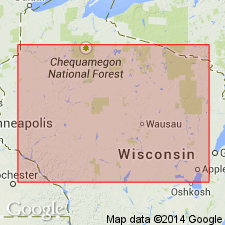
- Usage in publication:
-
- Sylvan Lake Member
- Modifications:
-
- Principal reference
- Dominant lithology:
-
- Till
- Sand
- Gravel
- Silt
- Clay
- AAPG geologic province:
-
- Wisconsin arch
Summary:
Pg. vi (chart), 41-46. Sylvan Lake Member of Copper Falls Formation. (Follows informal usage of M.D. Johnson, 1986, Wisconsin Geol. Nat. Hist. Survey Inf. Circ., no. 55, 42 p., and M.D. Johnson, 1984, Univ. Wisconsin PhD dissert.) Occurs in Superior Lobe, northwestern Wisconsin. Consists of till, stream sediment, and lake sediment. Till is unbedded, slightly gravelly to gravelly, sandy loam, and in part, loamy sand. Top 2.5 to 5 m is a dark reddish brown oxidized and leached zone. Pebble fabric indicates ice flow was to southeast. Commonly exposed in hummocky topography; thickness 5 to 45 m. At type section, underlies interbedded till and sediment of Sylvan Lake. Lower contact seldom exposed but is ommonly found overlying sand and gravel in drillholes. Stream sediment is cross-bedded, horizontally bedded, and contains imbricated gravel. Thickness 10+ m. Deposited by supraglacial and proglacial streams. Occurs in pitted plains behind and in front of late St. Croix ice-margin position. Underlies thin layer of loess. Lower contact seldom observed; may overlie till of Sylvan Lake Member or sediments of Poskin Member. Lake sediment is sandy near former lake margins, thickness 10 to 15 m. Is silty beneath former lake centers, thickness 7 to 10 m. Deltas at former lake margins contain slightly gravelly sand and sand in topset and foreset beds. Bottomset beds are 1 to 30 mm-thick sand and silty sediment. Found in ice-walled-lake plains, northwest Barron County. Underlies loess; contact is sharp but difficult to identify where lake sediment is silty. Overlies till of Sylvan Lake Member with sharp contact. Age of Sylvan Lake is considered Pleistocene (late Wisconsinan). Deposited about 15,000 years ago (citing Clayton and Moran, 1982, Quat. Sci. Rev., v. 1, p. 55-82).
Type section: roadcut on south side of an east-west road [at south end of Sylvan Lake], in SE/4 SW/4 NW/4 sec. 14, T. 36 N., R. 13 W., [approx. Lat. 45 deg. 36 min. 15 sec. N., Long. 91 deg. 56 min. 44 sec. W.], northern edge Lower Vermillion Lake 7.5-min quadrangle, Barron Co., northwestern WI.
Named from Sylvan Lake, northern edge Lower Vermillion Lake 7.5-min quadrangle, Barron Co., northwestern WI.
Reference sections:
(1) till, in small borrow pit, east side of north-south road, in NW/4 SW/4 SW/4 sec. 20, T. 36 N., R. 12 W., [approx. Lat. 45 deg. 35 min. 03 sec. N., Long. 91 deg. 53 min. 18 sec.], eastern edge Lower Vermillion Lake 7.5-min quadrangle, Barron Co., northwestern WI;
(2) stream sediment, in a pit, in NE/4 SE/4 SE/4 sec. 36, T. 36 N., R. 13 W., [approx. Lat. 45 deg. 33 min. 24 sec. N., Long. 91 deg. 54 min. 42 sec. W.], Lower Vermillion Lake 7.5-min quadrangle, Barron Co., northwestern WI;
(3) lake sediment, in gravel pit, in SE/4 NW/4 SE/4 sec. 6, T. 33 N., R. 14 W., [approx. Lat. 45 deg. 22 min. 20 sec. N., Long. 92 deg. 08 min. 37 sec. W.], Clayton 7.5-min quadrangle, Barron Co., northwestern WI.
[Additional locality information from USGS historical topographic map collection TopoView, accessed on June 9, 2018.]
Source: Publication.
For more information, please contact Nancy Stamm, Geologic Names Committee Secretary.
Asterisk (*) indicates published by U.S. Geological Survey authors.
"No current usage" (†) implies that a name has been abandoned or has fallen into disuse. Former usage and, if known, replacement name given in parentheses ( ).
Slash (/) indicates name conflicts with nomenclatural guidelines (CSN, 1933; ACSN, 1961, 1970; NACSN, 1983, 2005, 2021). May be explained within brackets ([ ]).

